Gaby Sylvia (1920-1980) had a remarkable career in French cinema of the late 1930s, 1940s and 1950s. She had an even more intense career on the French stage starring in plays by Jean Giraudoux and Jean-Paul Sartre.
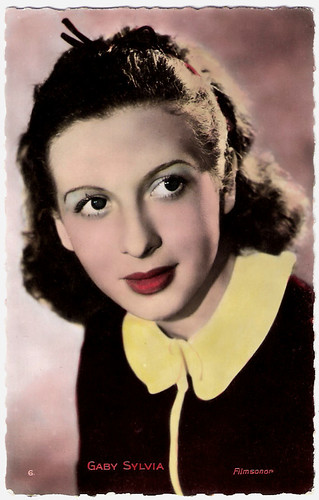
French postcard by Ed. Chantal, Paris, no. 6. Photo: Filmsonor.
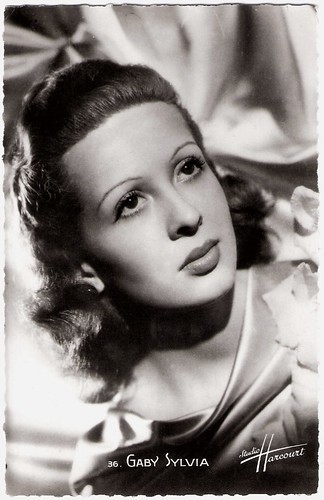
French postcard by S.E.R.P., Paris, no. 36. Photo: Studio Harcourt.
Gaby Sylvia was born Gabriella Zignani in Cesena, Italy, in 1920. She was still a child, when her family moved to France.
While she already played secondary roles in films in the late 1930s and the war years, Gaby Sylvia started to have leading parts in the immediate postwar era.
In 1947 she had the female lead in Capitaine Blomet/ aptain Blomet (Andrée Feix, 1947), staring Fernand Gravey, as well as in the Pierre Loti adaptation Le Marriage de Ramuntcho/The Marriage of Ramuntcho (Max de Vaucorbeil, 1947), considered the first French colour film. The title role was played by André Dassary.
In the late 1940s her most interesting films include the resistance film Mission à Tanger (André Hunebelle, 1949), starring Raymond Rouleau, and the comedy L'Amant de paille/The Straw Lover (Gilles Grangier, 1950), with a debuting Louis de Funès and Jean-Pierre Aumont.
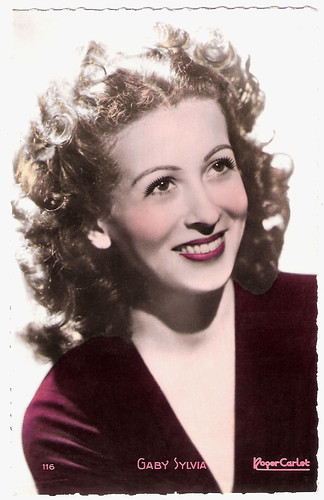
French postcard, no. 116. Photo: Roger-Carlet.
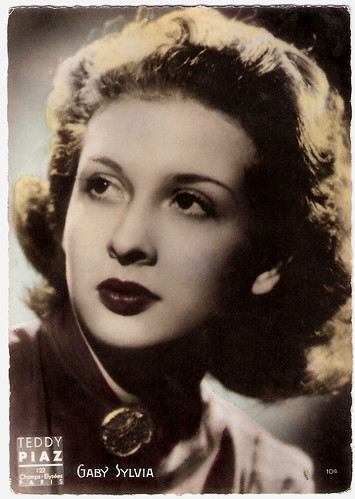
French postcard by Editions O.P., Paris, no. 104. Photo: Teddy Piaz.
Gaby Sylvia played Sylvia, a wealthy baby killer Estelle Rigault opposite Arletty in the Jean-Paul Sartre adaptation Huis clos/No Exit (Jacqueline Audry, 1954). She had also played Estelle in the first stage version of Huis clos, which had its first night on 27 May 1944, at the Théàtre du Vieux-Colombier, and was directed by Raymond Rouleau.
In addition to her role in Sartre's Huis clos, which she repeated on stage in 1961, Sylvia often played in plays by Jean Giraudoux, such as Amphytryon (1956, 1958), and also repeatedly performed in the comedy Piège pour un homme seul (1960, 1962, 1971) by Robert Thomas.
Her reperetory ranged from classics like Molière and Racine to modern writers like Giraudoux, Sarte and Thomas. Between the late 1930s and late 1950s Rouleau directed her in various stage plays.
From the late 1950s on, her stage directors were men like Raymond Gérôme (late 1950s), Jacques Charon (early 1960s), Antoine Bourseiller (mid-1960s), and Andréas Voutsinas (1970s). In 1976 Gaby Sylvia said goodbye to the stage with a performance in Huis clos, directed by Voutsinas.
In 1977 she also played her last film role in the comedy Nous irons tous au paradis/We Will All Meet in Paradise by Yves Robert.
Just turned sixty, Gaby Sylvia died in 1980 in Chamalières (Puy-de-Dôme) in the French Auvergne, because of a brain haemorrhage.
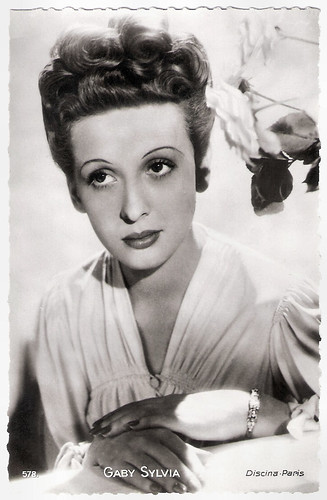
French postcard by Collection Chantal, Paris, no. 578. Photo: Discina, Paris.
Huis Clos/No Exit (1954). Sorry, no subtitles. Source: Classic Movies (YouTube).
Sources: Simon Condès (CinéArtistes - French), Wikipedia (French) and IMDb.

French postcard by Ed. Chantal, Paris, no. 6. Photo: Filmsonor.

French postcard by S.E.R.P., Paris, no. 36. Photo: Studio Harcourt.
The First French Colour Film
Gaby Sylvia was born Gabriella Zignani in Cesena, Italy, in 1920. She was still a child, when her family moved to France.
While she already played secondary roles in films in the late 1930s and the war years, Gaby Sylvia started to have leading parts in the immediate postwar era.
In 1947 she had the female lead in Capitaine Blomet/ aptain Blomet (Andrée Feix, 1947), staring Fernand Gravey, as well as in the Pierre Loti adaptation Le Marriage de Ramuntcho/The Marriage of Ramuntcho (Max de Vaucorbeil, 1947), considered the first French colour film. The title role was played by André Dassary.
In the late 1940s her most interesting films include the resistance film Mission à Tanger (André Hunebelle, 1949), starring Raymond Rouleau, and the comedy L'Amant de paille/The Straw Lover (Gilles Grangier, 1950), with a debuting Louis de Funès and Jean-Pierre Aumont.

French postcard, no. 116. Photo: Roger-Carlet.

French postcard by Editions O.P., Paris, no. 104. Photo: Teddy Piaz.
Wealthy Baby Killer
Gaby Sylvia played Sylvia, a wealthy baby killer Estelle Rigault opposite Arletty in the Jean-Paul Sartre adaptation Huis clos/No Exit (Jacqueline Audry, 1954). She had also played Estelle in the first stage version of Huis clos, which had its first night on 27 May 1944, at the Théàtre du Vieux-Colombier, and was directed by Raymond Rouleau.
In addition to her role in Sartre's Huis clos, which she repeated on stage in 1961, Sylvia often played in plays by Jean Giraudoux, such as Amphytryon (1956, 1958), and also repeatedly performed in the comedy Piège pour un homme seul (1960, 1962, 1971) by Robert Thomas.
Her reperetory ranged from classics like Molière and Racine to modern writers like Giraudoux, Sarte and Thomas. Between the late 1930s and late 1950s Rouleau directed her in various stage plays.
From the late 1950s on, her stage directors were men like Raymond Gérôme (late 1950s), Jacques Charon (early 1960s), Antoine Bourseiller (mid-1960s), and Andréas Voutsinas (1970s). In 1976 Gaby Sylvia said goodbye to the stage with a performance in Huis clos, directed by Voutsinas.
In 1977 she also played her last film role in the comedy Nous irons tous au paradis/We Will All Meet in Paradise by Yves Robert.
Just turned sixty, Gaby Sylvia died in 1980 in Chamalières (Puy-de-Dôme) in the French Auvergne, because of a brain haemorrhage.

French postcard by Collection Chantal, Paris, no. 578. Photo: Discina, Paris.
Huis Clos/No Exit (1954). Sorry, no subtitles. Source: Classic Movies (YouTube).
Sources: Simon Condès (CinéArtistes - French), Wikipedia (French) and IMDb.
No comments:
Post a Comment